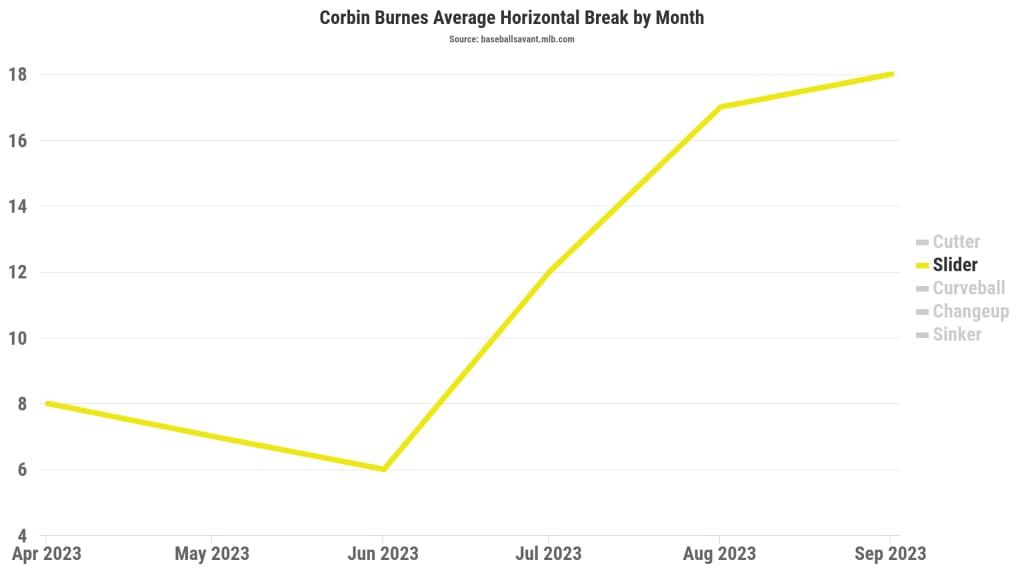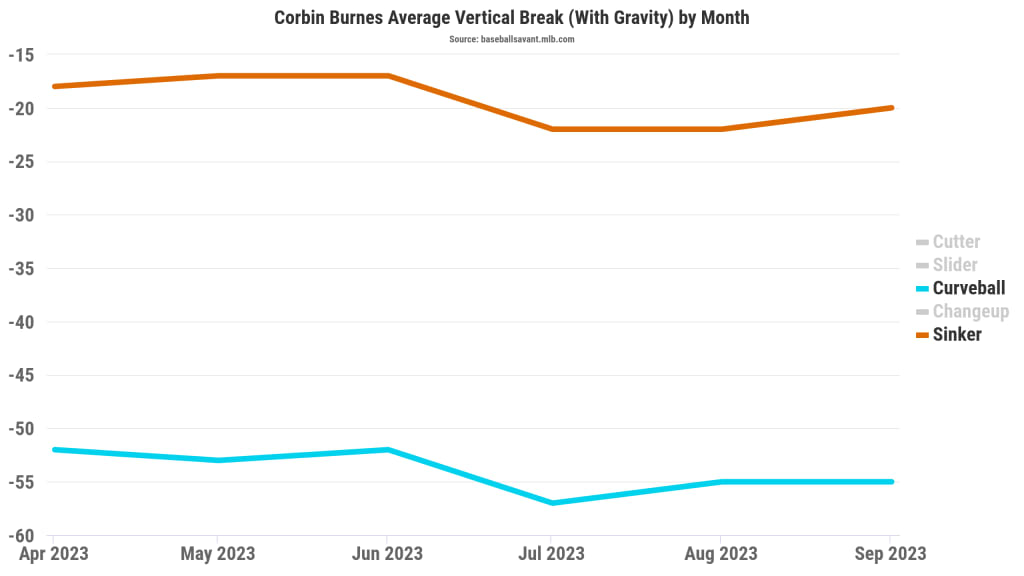Corbin Burnes has always had some of the least hittable stuff in the world. But the Orioles' new ace had to make some changes to keep himself unhittable entering 2024.
He did just that, and now he should make a 101-win, American League East-champion Baltimore team even better.
Burnes, who the O's just landed in a blockbuster trade with the Brewers, has looked a lot more like his Cy Young-winning self since the start of last summer. His start to the 2023 season was surprisingly rocky, as he slogged to a 4.10 ERA through the end of June while striking out under a batter per inning. But Burnes righted the ship after that, posting a 2.72 ERA and 10.1 K/9 over the final three months of the season while reaching the 200-strikeout mark for a third straight year.
Here's what's been different about Burnes since the start of that run. Look for these three key adjustments when he takes the mound for Baltimore for the first time.
1) He's made his slider into a "sweeper"
Here is a plot of the horizontal break on Burnes' slider by month. See if you can spot the difference …

Yes, Burnes' slider movement doubled out of nowhere in July, from 6 inches to 12 inches. Then it jumped again, all the way up to 17 inches in August, and to a season-high 18 inches in September.
He added a full foot of break between June and the end of the season. By the time the postseason began, Burnes' slider was breaking more than the full, 17-inch width of home plate.
That's not a traditional slider, that's a sweeper -- even if Burnes doesn't want to call it that. ("I don't know what a sweeper is. I know what a slider is," he told MLB.com Brewers reporter Adam McCalvy.)
The point is, Burnes' sweeping slider works like an entirely new pitch. And that's huge for the way he attacks right-handed hitters.
Burnes, like many pitchers, has a different pitch mix for righties and lefties. He throws his cutter and curveball to both, but he uses his changeup specifically against lefties and his sinker and slider specifically against righties.
That's why the change to the "sweeper" style of slider -- with its Frisbee-like horizontal break, as opposed to the tight vertical break of a traditional slider -- makes so much sense. The biggest strength of the sweeper is the platoon advantage. A right-hander's sweeper is very effective in inducing weak contact from right-handed hitters, because it breaks so far away from the barrel of their bat. But that same sweeper might get crushed by lefties, because they can see it easier: The sweeping trajectory takes it into their hitting zone, and they have time to read the movement since a sweeper is slower than a normal slider.
Because Burnes almost always throws his slider to righties, that platoon weakness is eliminated. He has other weapons to get lefties out. So he doesn't need his slider to be a hard slider with tight movement. That's too similar to what his cutter does already.
Instead, Burnes took off velocity -- his slider sat around 84-85 mph from July onward, compared to 89-90 mph in the months before -- and added movement. And it's worked.
2) He's added depth to the pitches that need it
Here's another movement plot for Burnes, but this one's vertical movement. It's his sinker and curveball, the two pitches Burnes would want to induce downward break on.

That's exactly what he did in the second half. Burnes added depth to both pitches: five inches of sink to his sinker, four inches of drop to his curveball.
Burnes' sinker and curveball drop in 2023
- Sinker: 17 inches April-June | 22 inches July-September
- Curveball: 52 inches April-June | 56 inches July-September
With the sinker, Burnes added that movement without sacrificing any velocity, or the arm-side run on the pitch. It's still in the same 95-96 mph range, and getting the same 10-11 inches of run. The new drop just adds an extra dimension to the pitch.
And as for the curve, good luck hitting it when it's even sharper than it was before. Burnes' curveball was generating a 41% swing-and-miss rate and 46% strikeout rate through June. It generated a 55% swing-and-miss rate and 57% strikeout rate after July.
3) He's dominating the zone with his cutter
Burnes throws more cutters than any other starter. He throws his cutter over 55% of the time. It's his No. 1 pitch.
If you like to watch Burnes pitch, you understand why he loves that cutter. It's one of the nastiest pitches in baseball, and was one of the most valuable pitches of any kind thrown by any pitcher last season.
But Burnes' cutter is at its nastiest when he's attacking hitters with it full-on. His cutter is designed to overpower, not to nibble.
When he throws it in the zone, Burnes' cutter is one of the most effective pitches thrown by any Major League starting pitcher. By Statcast's run value metric, which considers the outcome of every pitch and how much it costs or prevents runs for his team, Burnes' cutter was a top-five in-zone pitch last season.
Most valuable pitches in the strike zone, 2023 SP
- Zac Gallen's 4-seamer: +45 runs prevented
- Gerrit Cole's 4-seamer: +42 runs prevented
- Chris Bassitt's sinker: +35 runs prevented
- Corbin Burnes' cutter: +31 runs prevented
- Blake Snell's 4-seamer: +29 runs prevented
In his Cy Young season in 2021, Burnes kept his cutter in the zone 55% of the time. But through the first three months of 2023, he was throwing under half of them in the zone, and trending the wrong way going into the summer.
He reversed that trend starting in July. Over the last three months of the season, Burnes got his in-zone cutter percentage up to 54%. Over his most unhittable stretch -- seven starts from July 1 to Aug. 5 in which Burnes allowed just 17 hits in 45 innings, second only to 2004 Johan Santana for fewest hits allowed in a seven-start span in the Live Ball Era -- Burnes went after hitters with cutters inside the strike zone 57% of the time.
Burnes' cutter is one of the most dominant in-zone pitches out there. He'll use it as such with the Orioles.
